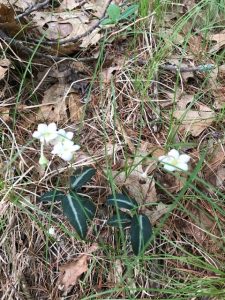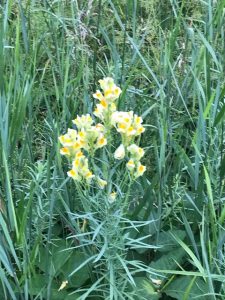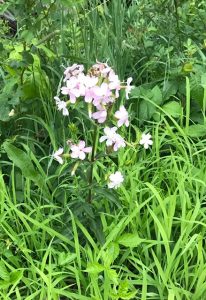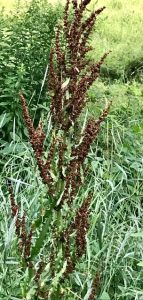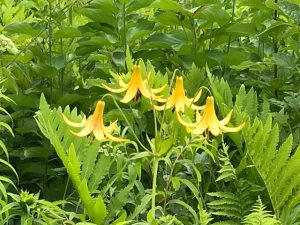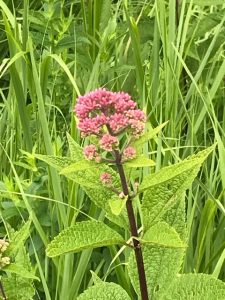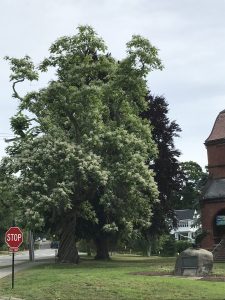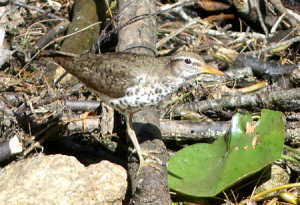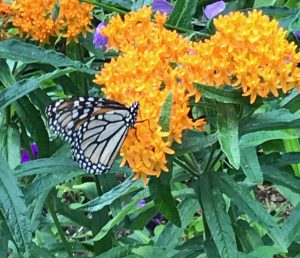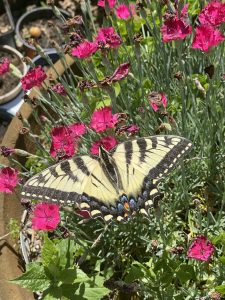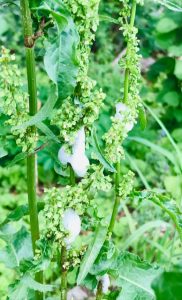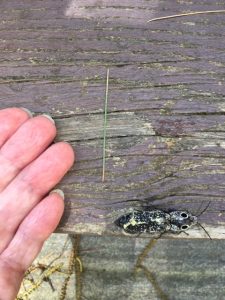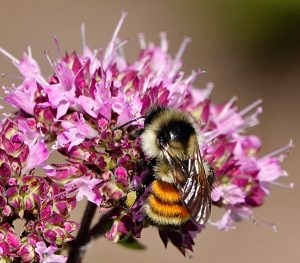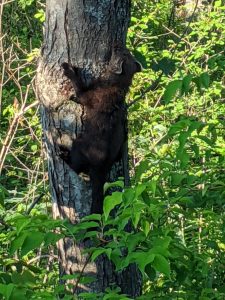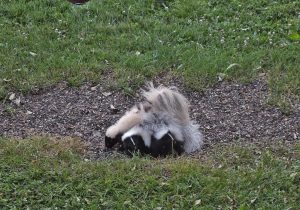Written by Gwyn Loud for the Lincoln Land Conservation Trust. She welcomes your sightings and questions at 781-259-8690 or gwynloud555@gmail.com.
June brought us about half the average rainfall for the month. Then a brief but severe thunderstorm blew through on July 2, with torrents of rain and wild winds in a microburst, bringing down power lines and trees in certain parts of town. So far rainfall has also been well below average for July and when rain comes, we seem to get it in brief deluges or teaser showers.
Greenery and blossoms abound and keeping up with weeding and pruning is a challenge for gardeners. On a walk in the woods look for spotted wintergreen in flower and mushrooms which have prospered from high humidity. Roadside flowers include butter and eggs, bouncing bet, and dock, whose seeds on spires are turning dark brown. Tall mullein, with yellow flowers and fuzzy leaves is hard to miss. In fields look for cow vetch, Queen Anne’s lace, black-eyed-Susans, red or white clover, and, if you are lucky, the spectacular Canada lily. Milkweed flowers are past the peak but Joe-Pye weed is just starting to blossom and will get to 6 feet tall over the next month. A couple of weeks ago catalpa trees were blooming, including our beloved “twisted tree” by the library. I have been watching all the wildlife enjoying the fruit in our mulberry tree, with squirrels and chipmunks climbing high and many species of birds eating the berries. An observer walking between Route 126 and Codman reported, “gorgeous red baneberries along the trail – poisonous but beautiful!” Black oaks, which produce acorns every year, are already dropping acorns in the road; white oaks are not so regular and predictable. It remains to be seen if this will be another big mast year, like 2019, when nuts, acorns, cones, and berries were extremely abundant and many species of birds, rodents, and other mammals were beneficiaries.
In the avian world bird song has diminished, fledglings are exploring new horizons and busy adults are caring for young, with many second broods completed. An observer watched a young brown-headed cowbird being fed by a Baltimore oriole, its foster mom. Cowbirds do not make their own nests but lay their eggs in the nests of other songbirds, leaving the unwitting host, often smaller in size than the cowbird, to raise the “guest.” In the past I have witnessed chickadees and chipping sparrows feeding young cowbirds which were twice the size of the adult. Along Weston Road there has been a large flock of wild turkeys, a blended family with four adults and 21 poults of different sizes. I have been watching two Cooper’s hawk nests along Conant Road, both high in white pines. The young, two in one nest and three in the other, are now full-grown and flying in nearby trees. I fear that, come winter, they will all be swooping through my bird-feeding area to snatch prey! Late on a recent night after rain a large barred owl was spotted in the road on Rt. 117 with traffic whizzing by. There were lots of frogs and toads in the road after the rain and the observer, driving by, thought the owl might have been attracted to an amphibian meal. The driver stopped and was able to coax the owl to safety off the road, where it flew into a tree.
The heat of summer brings out the insects and we are beginning to notice butterflies. Several people have reported monarchs; on milkweed look carefully for the white eggs the size of a pinhead, laid singly on the underside of a leaf near the top of the plant. In my garden I have seen a red admiral and clouded sulphurs and several observers wrote about seeing hummingbird moths, which look a lot like tiny hummingbirds. They are, however, members of the sphinx moth family, are diurnal, unlike most moths, and feed on nectar. In my flagstone walk golden digger wasps have taken up residence as usual at this season, digging burrows between the stones where the females will lay eggs.
If you come across little white bubbles of froth on a plant, you have found the protective strategy of the nymphs of the spittlebug. The little green nymph sucks the sap from the plant stem then pumps out excess water from its abdomen along with glandular secretions to make a sticky and tough protective mass. Eventually the nymph molts to a winged adult. One resident found a click beetle, so-named because it has a clicking mechanism mainly used to avoid predators which enables it to bounce into the air. Cicadas have just emerged, meaning that we will soon be hearing their buzzy calls, along with insects such as katydids and crickets. Fireflies have put on a good show, as reported by a Weston Rd. resident: “By far the best sighting in the past month was many nights of hundreds of fireflies in the fields next to where I live. This was breathtaking! The first night I saw the all twinkling on and off I got goosebumps. I have not ever seen as many and it was like one of those firefly “shows” in Japan that people venture to for certain dates each year.”
As part of Lincoln’s pollinator initiative Norman Levey has been identifying bumblebee species and their flower choices for nectar and pollen. He has so far identified seven species, one never recorded before in Lincoln. Norman is participating in the Beecology Project on which Dr. Robert Gegear is the lead scientist.
An exciting mammal report was of a bobcat which crossed Lincoln Road near Todd Pond Rd. Bobcats, quite secretive, are reported sporadically in our metro-west area. Deer, raccoons, woodchucks, red foxes and coyotes are ever-present and both rabbits and chipmunks seem especially numerous this year.
A resident captured a short tailed weasel catching a chipmunk on film, and at Drumlin Farm four otters were seen playing in the Ice Pond. A family of fishers was spotted near Baker Bridge Road, and another observer photographed a surfeit of skunks (yes, that is the correct collective name for a group of skunks!) with three babies struggling to huddle underneath their mother.
This column will resume in September, but in the meantime, enjoy the bounty of nature in August. Looking skyward, in the early morning hours of August 11, 12, and 13 watch for the annual Perseid meteor shower, a favorite summertime astronomy show.
© Gwyn Loud


